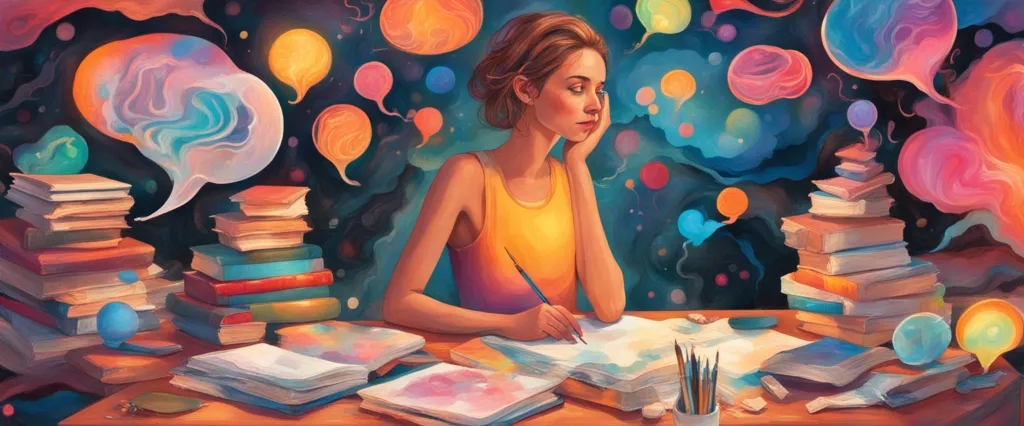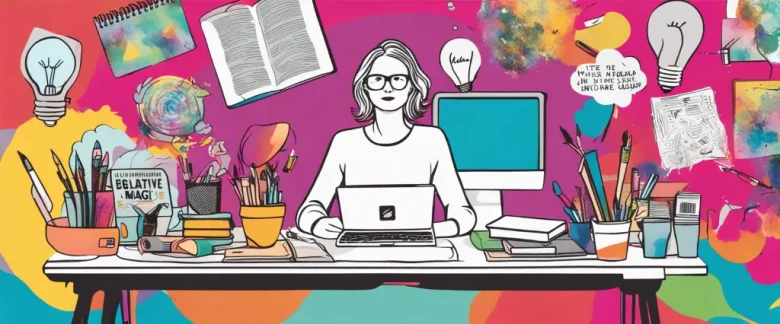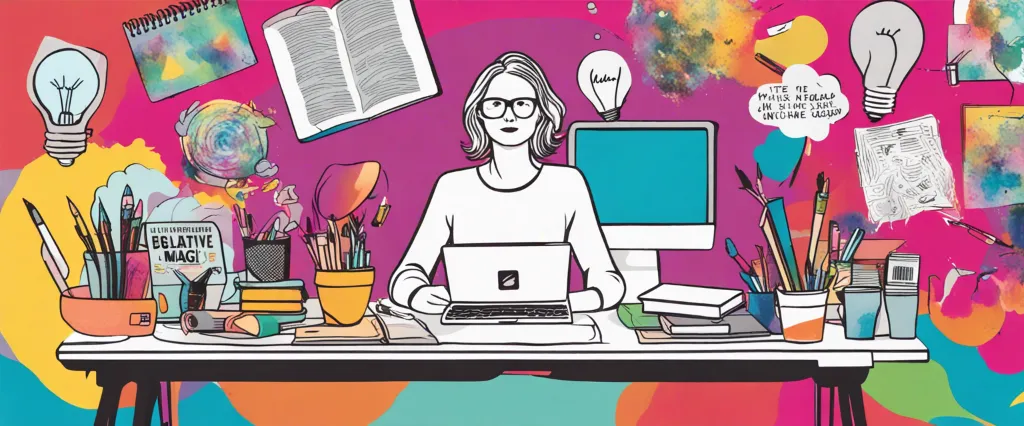In her empowering and enchanting book, “Big Magic,” acclaimed author Elizabeth Gilbert invites readers on a captivating journey to unlock the possibilities of their creativity. Drawing from her own personal experiences and encounters with elusive inspiration, Gilbert shares profound insights and practical wisdom to encourage individuals to courageously pursue their deepest creative desires. As the author of the beloved memoir “Eat Pray Love,” Elizabeth Gilbert has captivated millions with her authentic storytelling and keen understanding of the human spirit. Her works explore themes of self-discovery, resilience, and the pursuit of a fulfilling life. With “Big Magic,” Gilbert once again ignites a spark within readers, inspiring them to embrace their creative potential and fearlessly engage with the world.
Chapter 1: Exploring the Magic of Creativity
In this chapter, Elizabeth Gilbert sets the foundation for her exploration of creativity and the magic it holds. She emphasizes that creativity exists in every individual, not just talented artists, and it is essential to nurture and appreciate its presence.
Gilbert introduces the idea of “Big Magic,” which describes the mystical and enchanting nature of creativity. She believes that ideas have a life of their own and are searching for the perfect person to bring them to life. Creativity is a collaborative process between the creator and the idea itself, where ideas seek a willing vessel to manifest.
The author acknowledges that every creative journey is different, and its outcome is unpredictable. She encourages readers to release expectations and not burden their creativity with the pressure of success or originality. Gilbert believes that creativity should be pursued for its own sake, not for external validation or rewards.
To demonstrate the presence of Big Magic, Gilbert shares a personal anecdote about a novel idea she had, which she did not pursue. A few years later, she discovered that another author wrote a book with almost the identical premise. This incident solidifies her belief that ideas are independent entities that can move from person to person if not nurtured and pursued.
Throughout the chapter, Gilbert also emphasizes the importance of curiosity, playfulness, and discipline in the creative process. She highlights the need for courage to face self-doubt, criticism, and the fear of failure. Gilbert concludes the chapter by inviting readers to embark on their creative journeys, open to the magic that awaits them.
Chapter 2: Embracing the Courage of Creativity
In Chapter 2 of “Big Magic” by Elizabeth Gilbert, titled “Embracing the Courage of Creativity,” Gilbert explores the concept of fear and its impact on creativity. She believes that fear is an inherent part of the creative process and that we must learn to embrace it rather than letting it control us.
Gilbert begins by acknowledging that fear is a natural response, programmed to protect us from danger. However, she argues that fear often becomes overactive in today’s society, hindering our ability to create and explore our passions. Gilbert notes that fear can manifest in different ways, such as self-doubt, perfectionism, or the fear of failure or rejection.
To counteract fear, Gilbert suggests cultivating a relationship with creativity built on trust and curiosity. She encourages readers to approach their creative endeavors with a sense of playfulness, allowing room for mistakes and growth. Gilbert reminds us that creativity is about expressing ourselves rather than seeking external validation or success. By focusing on the process rather than the outcome, we can overcome the fear that inhibits our creativity.
Furthermore, Gilbert emphasizes the importance of making space for creativity in our lives. She advises us to set aside time to pursue our passions, even if it means dedicating only a few minutes each day. Gilbert argues that by making a commitment to creativity, we send a message to the universe that we are ready to embrace inspiration whenever it may come.
In summary, Chapter 2 of “Big Magic” explores the role of fear in creativity and encourages readers to develop a healthy relationship with it. By embracing fear as a companion on our creative journey, adopting a playful mindset, and making space for creativity, we can unlock the courage to pursue our passions and unleash our creative potential.
Chapter 3: Transcending the Fear of Creating
Chapter 3 of “Big Magic” by Elizabeth Gilbert is titled “Transcending the Fear of Creating”. In this chapter, Gilbert explores the relationship between fear and creativity, emphasizing the importance of facing and overcoming fear in order to live a creative life.
Gilbert begins by discussing the notion that fear and creativity inherently coexist. She believes that fear is an inescapable part of the creative process, as it often arises when one is stepping outside their comfort zone and taking risks. However, she also emphasizes that fear should not govern or control one’s creative journey.
The author shares personal anecdotes and stories to demonstrate how fear can hinder creativity. She recounts instances where people have let fear prevent them from pursuing creative endeavors, leading to missed opportunities and regrets. Gilbert highlights the significance of acknowledging fear’s presence but not letting it dictate one’s choices.
Moreover, Gilbert introduces the concept of “creative entitlement” – the belief that each person has the right to express their creativity. She argues that everyone is inherently creative and that it is a vital part of being human. Embracing this belief helps individuals overcome the fear of judgment or failure, as it allows them to focus on the joy and fulfillment found in creating.
Throughout the chapter, Gilbert offers practical advice and strategies to transcend the fear of creating. She suggests cultivating curiosity, rather than relying solely on passion. She encourages embracing the role of “trickster” and approaching creativity with a lighthearted, playful attitude. Finally, Gilbert emphasizes the importance of persistence and action, urging readers to keep pushing through fear and to keep creating.
In summary, Chapter 3 of “Big Magic” explores the intertwining relationship between fear and creativity. Gilbert emphasizes the need to acknowledge fear without allowing it to hinder creative expression. Through personal anecdotes and practical advice, she encourages readers to embrace their creative entitlement and approach creativity with curiosity, lightness, and perseverance.
Chapter 4: Conversing with Inspiration

Chapter 4 of “Big Magic” by Elizabeth Gilbert is titled “Conversing with Inspiration.” In this chapter, Gilbert explores the relationship between creativity and the power of inspiration.
Gilbert begins by emphasizing the idea that ideas and inspiration are living entities, constantly in search of a human partner who is open and receptive. She compares this process to a dance, where both creativity and the artist play their part. She argues that inspiration seeks out those who are already actively engaged in their creative pursuits rather than those who are idle.
Furthermore, she explores the concept that inspiration can slip away if it is not pursued promptly. Gilbert shares numerous anecdotes where she missed out on creative ideas because she failed to act on them promptly. To her, inspiration is a benefactor that rewards those who demonstrate diligence, devotion, and respect towards their creative endeavors.
Gilbert suggests that in order to maintain a healthy relationship with inspiration, creators need to establish consistent routines and practices. She encourages creators to show up and put in the effort, knowing that inspiration will meet them halfway. She believes in treating inspiration with kindness and respect, instead of succumbing to a martyrdom mentality.
The chapter ends with Gilbert sharing a personal story of when she truly conversed with inspiration. She describes receiving and nurturing an idea that eventually turned into her bestselling novel, “Eat, Pray, Love.” Through this story, she emphasizes the importance of being prepared, open, and receptive to inspiration, as well as the rewards that come from engaging with it deeply.
In summary, Chapter 4 of “Big Magic” emphasizes the importance of actively engaging with inspiration in a committed and disciplined manner. It highlights how inspiration seeks out those who consistently show up for their creative work, and how missed opportunities can occur if action is not taken promptly. Gilbert suggests that by establishing routines, demonstrating respect, and being open to inspiration, creators can cultivate a more profound and fruitful relationship with their creative pursuits.
Chapter 5: The Power and Responsibility of Creativity
Chapter 5 of “Big Magic” by Elizabeth Gilbert titled “The Power and Responsibility of Creativity” explores the author’s perspective on the role and impact of creativity in our lives.
Gilbert begins the chapter by emphasizing the potential and power of creativity. She believes that creativity is a force that exists independently, outside of ourselves, and seeks out willing partners to collaborate with. Gilbert argues that we are all born with inherent creative abilities, and it is our responsibility to nurture and bring them to life. Additionally, creativity is not limited to traditional artistic pursuits but can be found in every aspect of life.
The author further delves into the idea that creativity is a reciprocal process. When we engage with our creative ideas and commit to them, they also commit to us, providing their own lessons and wisdom. Gilbert encourages readers to embrace creative work with a sense of playfulness and curiosity, rather than viewing it as a source of pressure and stress. She believes that if we approach creativity with love, it will reward us in unimaginable ways.
Gilbert also suggests that we need to let go of the idea that creativity must always be original. Instead, she proposes that we should focus on creating authentic work that reflects our truth and experience. In doing so, we connect with others on a more profound level and contribute to the collective pool of creativity.
The chapter concludes with Gilbert reminding readers of the responsibility that comes with creative living. She believes that when we deny our creative inclinations, we are not only robbing ourselves but also others who could benefit from our unique contributions. Therefore, it is essential to embrace our creative instincts and cultivate a relationship with creativity that is simultaneously joyful, respectful, and wholehearted.
In summary, Chapter 5 of “Big Magic” emphasizes the power, reciprocity, and responsibility of creativity in our lives. Gilbert encourages readers to nurture their creative instincts, approach their work with playfulness, and be authentic in their creative endeavors. She emphasizes the importance of not denying our creativity and urges readers to embrace the transformative potential that creative living brings.
Chapter 6: Pursuing Personal Creativity
Chapter 6: Pursuing Personal Creativity of “Big Magic” by Elizabeth Gilbert explores the concept of personal creativity and the importance of pursuing one’s own creative passions.
Gilbert begins the chapter by emphasizing that everyone possesses inherent creativity, but it is up to the individual to embrace and nurture it. She encourages readers to make time for creativity, regardless of whether it leads to financial success or public recognition. Creativity, she argues, is about personal fulfillment and finding joy in the act of creation itself.
The author also addresses the fear and self-doubt that often accompany creative pursuits. Gilbert believes that fear is an inevitable part of the creative process, but it should not be allowed to hold back one’s creative expression. Instead, she encourages individuals to make peace with fear, acknowledging its presence but not allowing it to dictate their actions.
To foster personal creativity, Gilbert advises readers to be curious and open-minded, exploring multiple creative outlets without worrying about achieving perfection. She emphasizes the importance of experimentation and not being afraid to make mistakes. Gilbert also highlights the value of dedicating time to creative pursuits even when they may not seem productive in the conventional sense.
Furthermore, the author discusses the role of discipline and persistence in nurturing creativity. She believes that committing to a regular creative practice, even during moments of self-doubt or lack of inspiration, is crucial for personal growth and the development of creative skills.
In summary, Chapter 6 of “Big Magic” encourages individuals to embrace their personal creativity and pursue creative passions for their own sake. It advises readers to make time for creativity, face and make peace with fear, be open-minded and curious, and cultivate discipline and persistence. Gilbert’s message is ultimately one of self-discovery, fulfillment, and finding joy in the creative process.
Chapter 7: Feasting on Creativity
Chapter 7 of “Big Magic” by Elizabeth Gilbert, titled “Feasting on Creativity,” delves into the author’s views on the importance of embracing creativity in our lives. Gilbert believes that creativity is not just reserved for artists or geniuses, but is an inherent part of being human. The chapter focuses on two main aspects: permission and persistence.
Gilbert emphasizes the need for individuals to grant themselves permission to pursue their creative endeavors and to let go of the fear that often holds them back. She encourages readers to reclaim their creative power by understanding that ideas and inspiration are not exclusive to anyone, but are constantly flowing through the universe, waiting for someone to seize them. Gilbert’s perspective challenges the commonly held belief that creative pursuits are only for the chosen few.
Furthermore, the author stresses the significance of persistence in nourishing creativity. Gilbert argues that in order to have a fulfilling and creative life, one must commit to showing up consistently, putting in the work, and remaining dedicated to their craft. She shares personal anecdotes about her own writing process, highlighting the importance of perseverance even when faced with inevitable challenges and setbacks.
In this chapter, Gilbert invites readers to approach creativity with a playful and lighthearted attitude rather than taking it too seriously. She encourages individuals to embrace curiosity, follow their passions, and celebrate the process of creating rather than solely focusing on the outcome. By granting ourselves permission and remaining persistent in our creative pursuits, Gilbert asserts that we can foster a more fulfilling and vibrant existence.

Chapter 8: Living the Miracle of Creativity
Chapter 8 of “Big Magic” by Elizabeth Gilbert, titled “Living the Miracle of Creativity,” explores the challenges and joys of leading a creative life. Gilbert encourages readers to embrace the uncertainties and contradictions that come with pursuing creative endeavors.
She begins by emphasizing the importance of prioritizing time for creative exploration, challenging the belief that creativity must always be serious and arduous. Instead, Gilbert suggests that a lighter approach, filled with playfulness, curiosity, and joy, can produce remarkable and unexpected results. She reminds readers that creativity does not have to be a never-ending struggle, but rather a delightful dance with the elusive muse.
Gilbert goes on to discuss the fear and self-doubt that often accompany creative pursuits. She emphasizes the idea that courage is not the absence of fear but the ability to act in the presence of fear. Gilbert acknowledges that all creative journeys involve setbacks and failures, but it is crucial to push through these moments with determination and resilience.
She also emphasizes the importance of finding one’s own creative tribe, a supportive network of like-minded individuals who can provide encouragement, inspiration, and constructive feedback. Gilbert suggests seeking out creative communities, workshops, or online platforms to connect with kindred spirits.
Furthermore, Gilbert explores the concept of creative entitlement, encouraging readers to believe they have the right to pursue their creativity without waiting for permission. She argues that creative ideas are abundant in the universe and can be seized by anyone willing to put in the effort.
In conclusion, Chapter 8 of “Big Magic” serves as a reminder that living a creative life requires embracing the unknown, facing fears, finding support, and asserting one’s own creative entitlement. Gilbert encourages readers to approach their creative pursuits with a sense of adventure and to live the miracle of creativity with openness, courage, and self-belief.
After Reading
In conclusion, “Big Magic” by Elizabeth Gilbert is a profound guide that encourages individuals to embrace their creativity and live a more fulfilling life. Gilbert’s playful and insightful exploration of the creative process, combined with personal anecdotes and practical advice, effectively illustrates how to overcome fear, adversity, and self-doubt in pursuit of one’s artistic passions. By emphasizing the importance of curiosity, discipline, and persistence, Gilbert inspires readers to lead a creative life driven by passion rather than perfection. With her infectious enthusiasm and empowering message, “Big Magic” leaves readers feeling inspired, motivated, and ready to unleash their own creative genius.
1. The Artists’ Way” by Julia Cameron – This seminal book is a must-read for anyone looking to unlock their creativity. It offers practical tips, exercises, and reflections to help you overcome creative blocks and open yourself up to inspiration.
2. Bird by Bird: Some Instructions on Writing and Life” by Anne Lamott – Lamott’s witty and honest writing style makes this book an enjoyable and insightful read. She offers valuable advice on the creative process, including both the challenges and rewards of writing.
3. “The War of Art: Break Through the Blocks and Win Your Inner Creative Battles” by Steven Pressfield – Pressfield delves into the psychological struggles that artists face, such as resistance and self-doubt. This book provides valuable strategies to overcome these obstacles and live a more creative life.
4. “Big Magic for Little Artists: A Guide for Everyday Creativity” by Gregg Pizzoli – Written specifically for younger readers, this book is a delightful and accessible exploration of creativity. Pizzoli encourages children to embrace their imagination, take risks, and find joy in their artistic endeavors.
5. “The Creative Habit: Learn It and Use It for Life” by Twyla Tharp – Tharp, a world-renowned choreographer, shares her insights on developing and maintaining a creative routine. Through personal anecdotes and practical exercises, she helps readers cultivate creativity as a lifelong habit.
These five books dive into various aspects of creativity, offering both practical guidance and inspirational anecdotes. Whether you are an artist, writer, or simply seeking more creativity in your life, these books can provide valuable insights and encouragement.




